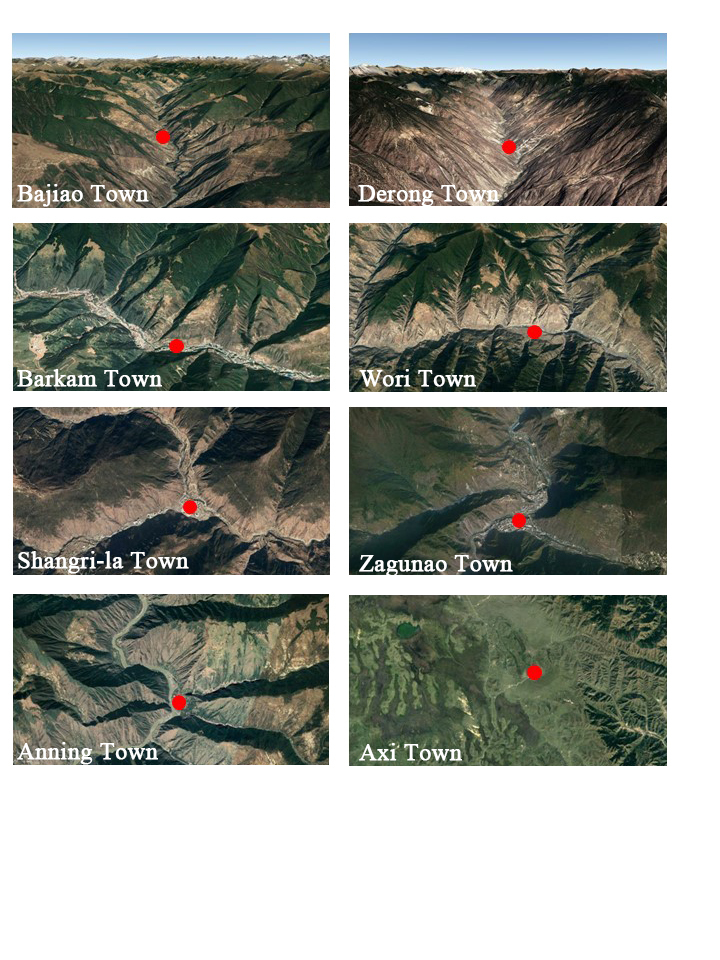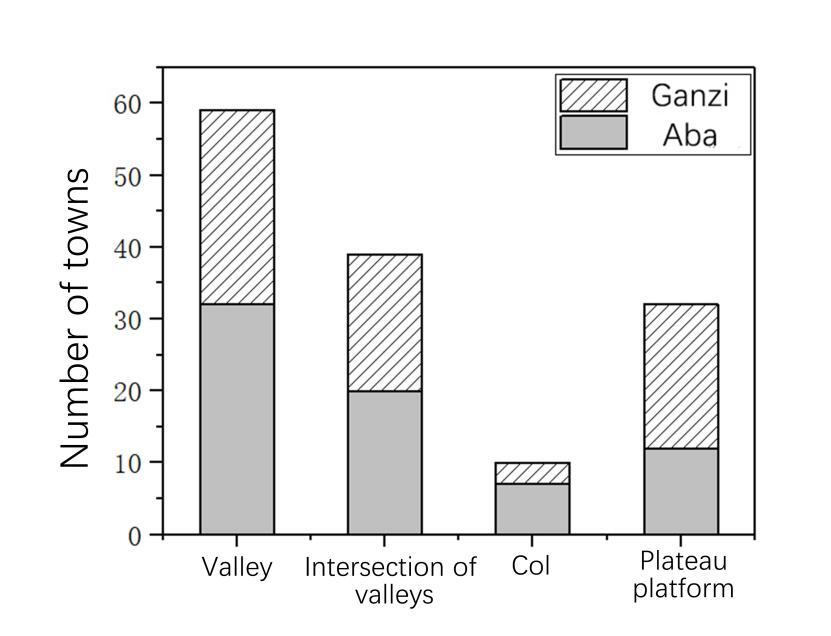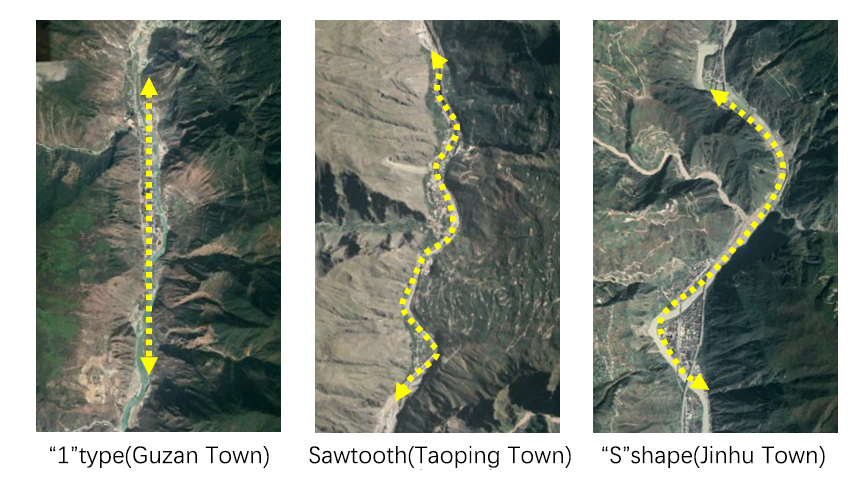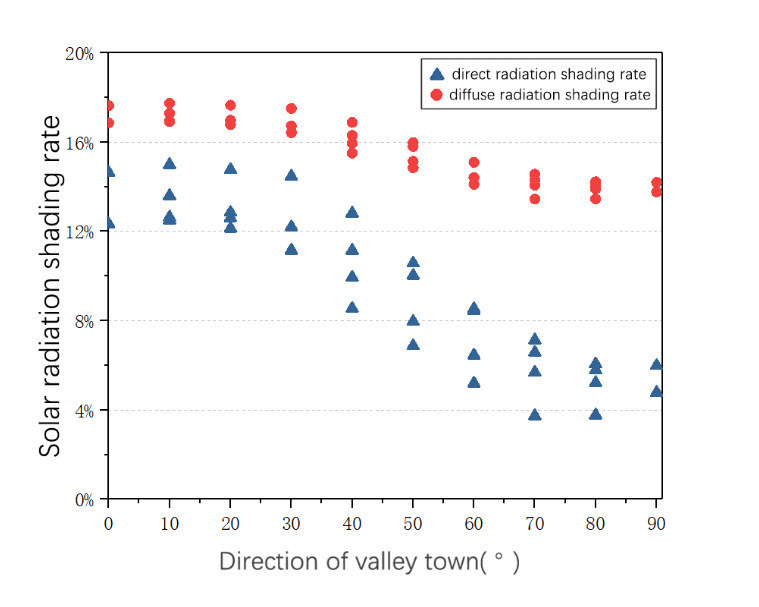0. Introduction
With the increasing severity of global climate change and environmental issues, solar energy, as a clean and renewable energy source, has been widely applied in the field of construction. Since the implementation of the "Solar Roof Program" in China in 2009, various provinces and cities have successively introduced "Sunshine Policies," leading to a rapid development of solar roof projects nationwide [1]. The potential of rooftop solar photovoltaic systems is immense, and analysing the solar energy resources in a region and estimating the solar radiation on building roofs are of significant importance.
The average altitude of the western Sichuan plateau is above 4000m, characterized by a thin and clean atmosphere, good transparency, low latitude, and long sunshine hours [2]. Most of western Sichuan is categorized as rich or relatively rich in solar energy, with annual total radiation ranging from 4200 to 6700 MJ/m2 and annual sunshine hours between 1600 and 2600 [3-5]. Based on the zoning indicators of annual total solar radiation, China can be divided into regions with abundant, relatively abundant, average, and deficient resources [6]. Analysis reveals that most areas in western Sichuan have relatively abundant solar energy resources. The towns in western Sichuan are spread across the entire region, characterized by high altitude, thin air, cold climate, and abundant solar energy resources. Effectively utilizing the local abundant solar energy has become an inevitable requirement to promote economic development and improve livelihoods.
However, due to a lack of attention and emphasis, the current utilization of solar energy in western Sichuan is not optimistic. Additionally, this region is located in the transitional zone between the Qinghai-Tibet Plateau and the Sichuan Basin, featuring towering mountains and significant terrain fluctuations, leading to pronounced shading effects on the solar radiation received by towns. Chen et al. [7], in predicting hourly solar radiation near the Heihe River Basin, found that terrain significantly influences the distribution of solar radiation. Liu et al. [8], from a hydrological perspective, simulated and discussed the actual spatial variability of solar radiation caused by terrain. For a small watershed in southern Germany, the difference in solar radiation between obstructed and unobstructed areas can be as high as 30% in winter and up to 5% in summer. Oliphant et al. [9] studied the size and reasons for spatial changes in solar radiation flux in complex mountainous areas in New Zealand, showing that the terrain has a significant impact on solar energy reception. Huang Pan [10], Guo Yubin [11], and others proposed accurate methods to analyse solar radiation estimation in the complex terrain of western Sichuan, revealing a close correlation between mountainous solar radiation distribution and topography. Zhong Yanchuan et al. [12], using a distributed model for solar direct radiation in undulating terrain, studied the spatiotemporal distribution of solar direct radiation in Sichuan Province and found that local terrain significantly affects the spatial distribution of annual solar direct radiation. Xiao Xuefei et al. [13], focusing on the solar environment of building plots in the valley terrain of western Sichuan, quantitatively analysed the spatiotemporal distribution characteristics of solar energy throughout the year, winter, and daily under the influence of valley terrain.
Although there are some studies on the shading effects of terrain on solar radiation, most existing research is conducted at a macro level, with relatively few specific analyses of the impact of a typical terrain on solar radiation. For the complex terrain of the western Sichuan plateau, characterized by high mountains and deep valleys, valley terrain is a typical landform, and its orientation is a key factor influencing the distribution of solar radiation on building roofs. Therefore, this study, based on a mountainous solar radiation estimation model, estimates the solar radiation shading rate on building roofs in valley towns of western Sichuan, aiming to thoroughly analyze the influence of valley orientation on the shading of solar radiation. This research will not only guide the architectural design layout of valley towns but also provide theoretical support for the utilization of solar energy on building roofs.
1. Estimation of Solar Radiation Shading Rate
In this study, we first used the model proposed by Xu [14] to estimate the direct and diffuse radiation received by building roofs in mountainous areas under the influence of complex terrain. Subsequently, the concepts of direct radiation shading rate and diffuse radiation shading rate were introduced to comprehensively analyse the shading effects of mountainous terrain on the direct and diffuse radiation on building roofs in valley towns. The annual direct radiation shading rate refers to the difference between the annual direct radiation under unobstructed conditions and the annual direct radiation under obstructed conditions, expressed as a ratio to the annual direct radiation under unobstructed conditions.
 (1)
(1)
Here, Edirect-0 represents the annual direct radiation under unobstructed conditions, and Edirect represents the annual direct radiation under obstructed conditions.
The annual diffuse radiation shading rate refers to the difference between the annual diffuse radiation under unobstructed conditions and the annual diffuse radiation under obstructed conditions, expressed as a ratio to the annual diffuse radiation received by the PV panel under unobstructed conditions.
 (2)
(2)
Here, Ediffuse-0 represents the annual diffuse radiation under unobstructed conditions, and Ediffuse represents the annual diffuse radiation under obstructed conditions.
2. Statistical Analysis of Valley Towns in Western Sichuan Plateau
Through on-site investigations and the utilization of Google Earth Pro, a detailed analysis of the topographical features surrounding 140 towns in western Sichuan was conducted. Figure 1 presents actual landscape images of the surroundings for eight representative towns. The analysis revealed that Axizhen is situated on a plateau with overall open and flat topography, resulting in minimal shading to solar radiation. The towns of Bajiao, Derong, Barkam, and Wori are located in flat areas between valley terrains, with significant shading to solar radiation caused by mountainous terrain on both sides of the valleys. Shangri-La and Zagunao are positioned in flat areas where two valleys intersect, dividing the surroundings of these towns into three distinct parts. Anning town is surrounded by tall mountains and is located in a col.

Figure 1. Actual Landscape Images of Eight Typical Towns in Western Sichuan
By classifying the surrounding topography of western Sichuan towns, four categories were identified: plateau platform, valley, intersections of valley, and col. Plateau platform refers to areas with relatively high terrain, flat surroundings, and minimal undulation. Valley represents locations situated between two relatively parallel mountainous terrains. Intersections of Valley refer to areas located at the confluence of three valleys. Col describes areas surrounded on all sides by steep mountains. Based on this classification, a statistical analysis of the topography of the surroundings of 140 towns in western Sichuan was conducted (Figure 2). The analysis revealed that, for the entire western Sichuan region, valley towns are the most numerous (59 towns), accounting for a high percentage of 42.14%. Valley intersection towns follow closely with 39 towns, constituting 28%. Plateau platform towns total 32, while col towns are the least numerous, with only 10.

Figure 2. Statistical Chart of Western Sichuan Towns Classification
3. Research Findings
For the numerous valley towns on the western Sichuan plateau, this study initially conducted a statistical analysis of the orientations of these valley towns. Subsequently, a fitting analysis based on the valley orientations was carried out to assess the solar radiation shading rates. Finally, focusing on a typical valley town, an in-depth exploration was undertaken to investigate the influence of different valley orientations on the solar radiation shading on town building roofs.
3.1. Valley Orientation Statistics
Valley orientation refers to the orientation of valleys or ravines in mountainous or hilly areas due to geological and hydrogeological factors, serving as a typical topographical element for valley towns. To analyze town orientations comprehensively, this paper quantified the deviation in degrees from true north for valley town orientations. The statistical results for the orientations of 59 valley towns in western Sichuan are shown in Figure 3. It is evident from the figure that the number of valley towns with orientations deviating between 0º and 45º comprises 41 towns, while those with orientations between 45º and 90º amount to 18 towns. This indicates that there are significantly more valley towns with north-south orientations than those with east-west orientations in western Sichuan.

Figure 3. Distribution Map of Valley Town Orientations
3.2. Impact of Valley Orientation on Shading Rates
To further analyze the impact of valley town orientation on solar radiation shading rates, this study treated valley town orientation as the independent variable. Separate regression analyses were conducted for the annual direct radiation shading rate and the annual diffuse radiation shading rate as dependent variables, resulting in regression equations as shown in Table 1. However, after analyzing different regression models and examining statistics such as the F-value and coefficient of determination (R2) from the regression equation's significance test, it was found that the performance of all models was not ideal.
Table 1. Statistics of direct radiation shading rate model and diffuse radiation shading rate model (the direction of valley town)
equation |
Direct radiation shading rate models |
Diffuse radiation shading rate models |
||||
R2 |
F |
significance |
R2 |
F |
significance |
|
Quadratic curve |
0.070 |
2.059 |
0.137 |
0.002 |
0.068 |
0.935 |
Cubic curve |
0.103 |
2.076 |
0.114 |
0.067 |
1.290 |
0.287 |
Composite curve |
0.108 |
6.786 |
0.012 |
0.001 |
0.030 |
0.864 |
growth curve |
0.108 |
6.786 |
0.012 |
0.001 |
0.030 |
0.864 |
Exponential curve |
0.108 |
6.786 |
0.012 |
0.001 |
0.030 |
0.864 |
logic function |
0.108 |
3.258 |
0.098 |
0.001 |
0.030 |
0.864 |
Although valley orientation is a highly typical topographical feature for valley towns, analyzing the correlation between the orientations of 59 valley towns in western Sichuan and their shading rates revealed that the correlation was not apparent. To explore the reasons for this, a detailed analysis of the topography of valley towns in western Sichuan was conducted. The topography of these towns was further classified into three types: "1" shaped, sawtooth-shaped, and "S" shaped (Figure 4). Towns in different valley terrains experience varying degrees of shading. "1" shaped valley towns represent the most basic and ideal type, where the orientation significantly affects solar radiation reception. On the other hand, sawtooth-shaped and "S" shaped valley towns have continuously curving topographies, making it challenging to accurately determine town orientations, thus introducing errors into the orientation statistics.

Figure 4. Classification of Topography for Valley Towns in Western Sichuan
Additionally, the surrounding terrain heights of valley zones also impact solar radiation intensity. Valley towns in western Sichuan are surrounded by mountains with significant differences in elevation, resulting in varying slopes of surrounding mountains for valley towns with different orientations. When studying the correlation between valley town orientation and town solar radiation shading rates, the differences in surrounding mountain slopes would also affect the calculation results. Therefore, to clarify the correlation between valley town orientation and solar radiation shading rates, controlling for the size of surrounding mountain slopes is essential.
To eliminate interference from various factors, this study chose "1" shaped valley towns as the research objects for further discussion. Guzhan Town in western Sichuan, situated in the Dadu River Valley, has complex topography with high mountains. The Dadu River runs from north to south, creating a relatively flat terrain in the river valley, while the mountains on both sides exhibit steep and rugged characteristics. In the analysis process, with Guzhan Town as the origin, the town was rotated 36 times at 10º azimuthal intervals, and solar radiation shading rates were estimated for each rotation. The estimated solar radiation shading rates for Guzhan Town at different orientations are shown in Figure 5. It is evident from the figure that, for a specific "1" shaped valley town, the orientation significantly affects the shading of direct radiation compared to the shading of diffuse radiation. As the town orientation approaches 90º, i.e., east-west orientation, both direct and diffuse radiations are less affected by terrain shading.

Figure 5. Estimated Annual Solar Radiation Shading Rates for Guzhan Town at Different Orientations
For a specific valley town, when the surrounding mountain slope remains constant, the town orientation has a noticeable impact on the solar radiation shading rate. Additionally, valley towns with east-west orientations exhibit significantly lower solar radiation shading rates than those with north-south orientations. However, due to the constraint of river orientations on valley town orientations, in western Sichuan, where rivers mostly run in a north-south direction, the number of valley towns with north-south orientations is more than those with east-west orientations. Therefore, accurately assessing the shading effects of valley topography on solar radiation for town buildings in western Sichuan is of significant importance for the utilization of solar energy in town buildings.
4. Conclusion
Valley topography is a typical landform in mountainous regions. In the western Sichuan plateau, where solar energy resources are abundant, many towns nestled amidst towering mountains are situated in valley terrains. Statistical analysis reveals that in the western Sichuan region, the majority of towns, totaling 58, are located in valley terrains, accounting for a substantial 42.14%. To promote the utilization of solar energy in mountainous areas, a thorough investigation into the impact of valley topography on solar radiation shading on building roofs is crucial.
This study, based on a mountainous solar radiation estimation model, calculated the direct and diffuse radiation shading rates for building roofs in valley towns. Subsequently, utilizing valley town orientation as an independent variable and the annual direct and diffuse radiation shading rates as dependent variables, regression models were established. The analysis showed that the fitted formulas had relatively low R2 values, with the best-performing model reaching only 0.108. Upon closer examination, it was discovered that this was due to statistical errors in town orientation, as valley towns in western Sichuan can be classified into three types: "1" shaped, sawtooth-shaped, and "S" shaped. The accurate statistical determination of the actual orientation of sawtooth-shaped and "S" shaped valley towns proved challenging.
To explore the impact of valley town orientation on solar radiation shading on building roofs, this paper, after eliminating various interferences, focused on the simplest "1" shaped valley town morphology - Guzhan Town - for an in-depth discussion. By rotating the town at 10º azimuthal intervals and calculating solar radiation shading rates for each rotation, it was found that the town orientation significantly affects the shading of direct radiation compared to the shading of diffuse radiation. As the town orientation approaches 90º, i.e., east-west orientation, both direct and diffuse radiations are less affected by terrain shading.
Valley town orientation is a crucial factor influencing solar radiation shading on building roofs. Therefore, to promote the utilization of solar energy on building roofs in valley towns, especially in situations where the surrounding mountain slopes are similar, priority should be given to valley towns with east-west orientations. The analytical method proposed in this study for assessing solar radiation shading on building roofs in valley towns provides essential theoretical support for the utilization of solar energy in these areas.
References
[1]. Yin, Y. Q. (2010). The Current Status and Prospects of Solar Roof Applications in China. Popular Electricity, 26(12), 17-18.
[2]. Li, Y. Z. (2004). Feasibility of Solar Heating in Residential Buildings in Lhasa City. Solar Energy, (4), 42-44.
[3]. Liu, J. P., Yang, L., Liu, Y. F., Tian, G. M. (2011). Key Technologies and Applications of Low Energy Consumption Buildings on the Tibetan Plateau. Chinese Journal of Engineering Science, (10), 40-46.
[4]. Luo, Y. J. (2005). Solar Utilization Technology. Beijing: Chemical Industry Press.
[5]. Wang, T., Kong, C., Huang, L. H., Yuan, Q., Long, E. S. (2009). Discussion on the Utilization of Renewable Energy in Western Sichuan. Refrigeration and Air Conditioning: Sichuan, 23(004), 109-113.
[6]. Zheng, R. C. (2011). Technical Manual for Solar Hot Water Systems in Civil Buildings. Chemical Industry Press.
[7]. Chen R, Kang E, Ji X, Yang J, Wang] J. An hourly solar radiation model under actual weather and terrain conditions: A case study in Heihe river basin. Energy. 2007;32(7):1148-57.
[8]. Liu M, Bardossy A, Li J, Jiang Y. GIS-based modelling of topography-induced solar radiation variability in complex terrain for data sparse region. International Journal of Geographical Information Science. 2012;26(7-8):1281-308.
[9]. Oliphant AJ, Spronken-Smith RA, Sturman AP, Owens IF. Spatial variability of surface radiation fluxes in mountainous terrain. Journal of Applied Meteorology. 2003;42(1):113-28.
[10]. Huang, P., Zhao, W., Li, A. N. (2017). Estimation and Spatiotemporal Distribution Characteristics of Solar Radiation in Western Sichuan Mountainous Area. Journal of Mountain Science, 35(03), 420-428.
[11]. Guo, Y. B., Zhang, C. H. (2022). Estimation of Solar Radiation in Complex Terrain of Western Sichuan Based on Landsat 8. Plateau and Mountain Meteorology Research, 42(04), 104-109.
[12]. Zhong, Y. C., Xu, J. X., Guo, H. Y. (2015). Distributed Simulation and Spatiotemporal Distribution of Direct Solar Radiation in Complex Terrain of Sichuan Province. In 32nd Annual Meeting of the Chinese Meteorological Society S10 Atmospheric Physics and Atmospheric Environment. Sichuan Climate Center.
[13]. Xiao, X. F., Long, E. S., Li, H. Y., et al. (2018). Analysis of the Impact of Jia Valley Landform in Western Sichuan on the Spatiotemporal Distribution Characteristics of Solar Energy on Building Plots. In Proceedings of the 13th Architectural Physics Academic Conference of China Architecture Society (pp. 1382-1385).
[14]. Xu L, Long E, Wei J, Cheng Z, Zheng H. A new approach to determine the optimum tilt angle and orientation of solar collectors in mountainous areas with high altitude. Energy. 2021;237:121507.
Cite this article
Jiang,M.;Xu,L.;Lu,J.;Liu,L. (2024). Study on the impact of valley orientation on solar radiation shading of roofs in western Sichuan. Advances in Engineering Innovation,6,44-53.
Data availability
The datasets used and/or analyzed during the current study will be available from the authors upon reasonable request.
Disclaimer/Publisher's Note
The statements, opinions and data contained in all publications are solely those of the individual author(s) and contributor(s) and not of EWA Publishing and/or the editor(s). EWA Publishing and/or the editor(s) disclaim responsibility for any injury to people or property resulting from any ideas, methods, instructions or products referred to in the content.
About volume
Journal:Advances in Engineering Innovation
© 2024 by the author(s). Licensee EWA Publishing, Oxford, UK. This article is an open access article distributed under the terms and
conditions of the Creative Commons Attribution (CC BY) license. Authors who
publish this series agree to the following terms:
1. Authors retain copyright and grant the series right of first publication with the work simultaneously licensed under a Creative Commons
Attribution License that allows others to share the work with an acknowledgment of the work's authorship and initial publication in this
series.
2. Authors are able to enter into separate, additional contractual arrangements for the non-exclusive distribution of the series's published
version of the work (e.g., post it to an institutional repository or publish it in a book), with an acknowledgment of its initial
publication in this series.
3. Authors are permitted and encouraged to post their work online (e.g., in institutional repositories or on their website) prior to and
during the submission process, as it can lead to productive exchanges, as well as earlier and greater citation of published work (See
Open access policy for details).
References
[1]. Yin, Y. Q. (2010). The Current Status and Prospects of Solar Roof Applications in China. Popular Electricity, 26(12), 17-18.
[2]. Li, Y. Z. (2004). Feasibility of Solar Heating in Residential Buildings in Lhasa City. Solar Energy, (4), 42-44.
[3]. Liu, J. P., Yang, L., Liu, Y. F., Tian, G. M. (2011). Key Technologies and Applications of Low Energy Consumption Buildings on the Tibetan Plateau. Chinese Journal of Engineering Science, (10), 40-46.
[4]. Luo, Y. J. (2005). Solar Utilization Technology. Beijing: Chemical Industry Press.
[5]. Wang, T., Kong, C., Huang, L. H., Yuan, Q., Long, E. S. (2009). Discussion on the Utilization of Renewable Energy in Western Sichuan. Refrigeration and Air Conditioning: Sichuan, 23(004), 109-113.
[6]. Zheng, R. C. (2011). Technical Manual for Solar Hot Water Systems in Civil Buildings. Chemical Industry Press.
[7]. Chen R, Kang E, Ji X, Yang J, Wang] J. An hourly solar radiation model under actual weather and terrain conditions: A case study in Heihe river basin. Energy. 2007;32(7):1148-57.
[8]. Liu M, Bardossy A, Li J, Jiang Y. GIS-based modelling of topography-induced solar radiation variability in complex terrain for data sparse region. International Journal of Geographical Information Science. 2012;26(7-8):1281-308.
[9]. Oliphant AJ, Spronken-Smith RA, Sturman AP, Owens IF. Spatial variability of surface radiation fluxes in mountainous terrain. Journal of Applied Meteorology. 2003;42(1):113-28.
[10]. Huang, P., Zhao, W., Li, A. N. (2017). Estimation and Spatiotemporal Distribution Characteristics of Solar Radiation in Western Sichuan Mountainous Area. Journal of Mountain Science, 35(03), 420-428.
[11]. Guo, Y. B., Zhang, C. H. (2022). Estimation of Solar Radiation in Complex Terrain of Western Sichuan Based on Landsat 8. Plateau and Mountain Meteorology Research, 42(04), 104-109.
[12]. Zhong, Y. C., Xu, J. X., Guo, H. Y. (2015). Distributed Simulation and Spatiotemporal Distribution of Direct Solar Radiation in Complex Terrain of Sichuan Province. In 32nd Annual Meeting of the Chinese Meteorological Society S10 Atmospheric Physics and Atmospheric Environment. Sichuan Climate Center.
[13]. Xiao, X. F., Long, E. S., Li, H. Y., et al. (2018). Analysis of the Impact of Jia Valley Landform in Western Sichuan on the Spatiotemporal Distribution Characteristics of Solar Energy on Building Plots. In Proceedings of the 13th Architectural Physics Academic Conference of China Architecture Society (pp. 1382-1385).
[14]. Xu L, Long E, Wei J, Cheng Z, Zheng H. A new approach to determine the optimum tilt angle and orientation of solar collectors in mountainous areas with high altitude. Energy. 2021;237:121507.









